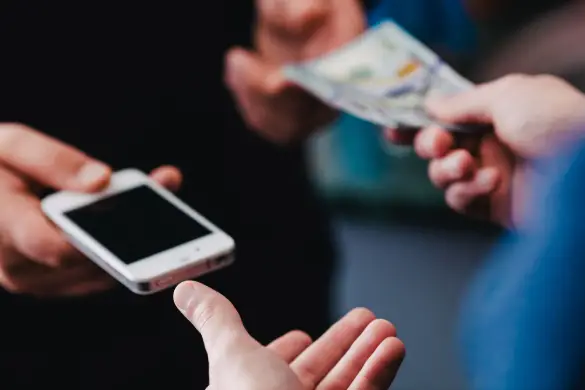
Apple offers iPhone buyback programs that can help to increase revenue as well as retain customers. They offer money for used, often obsolete devices. These savings can then be used to grow your business. Either through marketing or tangible, brick-and-mortar upgrades, your business will thrive off the capital from Apple’s iPhone buyback program. As a business owner, you should always be searching for cost-effective methods of growing your business. Since iPhones are pretty prevalent among the public, selling them back to Apple is as cost-effective as it gets. Read on to discover how the Apple buyback iPhone trade-in program works.
Preparing Devices
Preparing your device properly displays one aspect of how the buyback program works. A lot of personal and company information is stored on a phone, and much of it tends to be sensitive, such as credit card and bank details, names, addresses, and documents. Therefore, deleting this information from your device before trading it in is imperative in keeping this information safe. Apple recommends creating backups, then deleting this information off your device. Additionally, “Find my iPhone” must be disabled as well. Failure in doing so will result in your traded iPhone being rendered unusable after the trade-in. Of course, properly preparing your devices for a change in ownership presents a factor of how Apple’s iPhone buyback program works.
Eligible Devices
Listing eligible devices demonstrates another aspect of how Apple’s buyback initiative works. Not every device is eligible for compensation, so making sure your is becomes imperative in making the buyback program worthwhile. Some wear and tear is acceptable, but massive cracks or lapses in function will cause the device’s value to decline. Alternatively, Apple may not accept heavily damaged iPhones. In addition, only more recent devices will net you a profit. At the time of this writing, any model older than the iPhone SE is ineligible for reimbursement. However, any older models you may have laying around your business are worth trading in. Apple will still take them, but will not be paying you for them. Surely, ensuring the eligibility of your device displays a second factor in how Apple’s buyback program works.
Online vs. In-Store
Offering different service modalities for the digital and physical retail spaces demonstrates an additional aspect of how Apple’s buyback program works. Online, Apple has a web form where users can fill in information about their devices and receive estimates. From there, it is just a matter of filling in you address so Apple can send you a trade-in kit including a shipping box. Just put the device in the box and mail it back to Apple. They will also accept office work tablets, computers, and watches in this way. This is probably the best way to upgrade company iPhones and other Apple products. In store, it is just a matter of telling the employees that you want to trade in. Then, you will be able to decide if you want a gift card or to put that value towards a new purchase. Absolutely, having multiple avenues for users to trade-in displays a factor in how Apple’s buyback initiative works.
Internal Apple Trades
Apple tends to favor internal trade-ins more than simply paying for used iPhones. In fact, they do not even offer cash as an option for a trade-in payment. You can either put the value of your trade-in towards the purchase of a new product, or receive it as an Apple gift card. Whichever you choose, those funds are still locked into being spent with Apple. Therefore, it may be prudent to do company-wide upgrades at once. In addition, Apple tends to offer the maximum value on a device only when it is being traded in towards a new device. For instance, an iPhone X is valued at $349 on Apple’s official trade-in calculator. When using the trade-in value for a new device, Apple offers $450 for the same model. Keeping the funds involved internal to Apple presents another aspect of how their buyback initiative works.
Fate Of Traded Devices
Apple’s use of the devices they receive presents the final aspect of how their buyback program works. In general, the fate of a traded device depends on its condition. The ones in better condition are often resold. Of course, buying reconditioned iPhones can save you a fair amount of money. Conversely, the older and less functional devices are recycled for their components. These recycled materials are then used to repair iPhones and other devices. Therefore, sending even broken and non-functioning devices to Apple is a better option than simply throwing them in the trash. This is because they contain components detrimental to the environment. Sending a number of older company iPhones to the trash may net you some hefty fines. Definitely, the fate of traded devices demonstrates the final aspect of how Apple’s buyback initiative works.
Apple’s buyback iPhone programs can certainly help mitigate the high cost of their products due to the various aspects of how they work. Properly preparing your device will ensure its usability in the future. Making sure it is eligible for trade-in will ensure you get something in return. Apple’s decision to keep trade-in funds circulating internally ensures that the program is profitable for them, as well. In addition, presenting different methods for online and in-store trade-ins increases the accessibility of the program. Finally, how Apple uses the traded devices keeps the production of new iPhones cost-efficient. When thinking about how Apple’s buyback iPhone program works, consider the points above.
 Business First Family Business, Accounting, Finance, Investing, Marketing And Management
Business First Family Business, Accounting, Finance, Investing, Marketing And Management